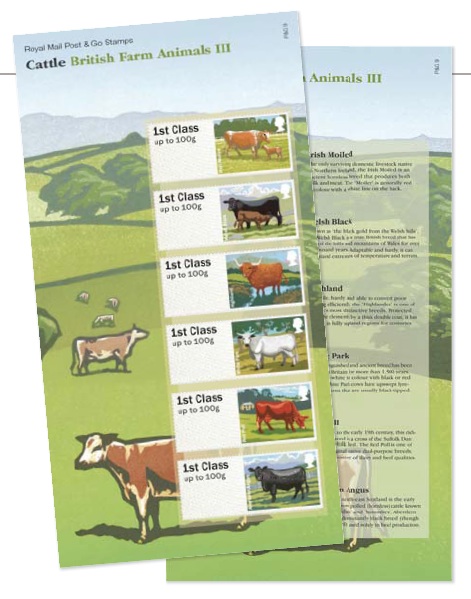Norvic Philatelics - GB New Stamps and Special Postmarks
Pictorial Faststamps: Cattle - 28 September 2012
Royal Mail is going down on the farm in 2012 with its new series of Post and
Go stamps. British Farm Animals is the first in a series of three issues
that will explore some of the many traditional breeds of sheep, cattle and
pigs to be found on farms in the UK. Post & Go terminals
allow customers to weigh their letters and packets, pay for and print
postage labels and stamps without the need to visit the counter. The first
Post & Go machine was trialled in The Galleries Post Office® in Bristol
in 2008.
The labels can be obtained with 6 different service indicators: 1st class up
to 100g & 1st class Large up to 100g, Europe up to 20g, Worldwide up to
10g and 20g, and the new Worldwide 40g. The stamps are dispensed
singly or in strips of up to 5 of the same value or various values. Thus
there are 36 different value/design combinations in total.

Row 1: Irish Moiled, Welsh Black, Highland
Row 2: White Park, Aberdeen Angus, Red Poll
|
|
The stamps in detail
Irish Moiled
The Irish Moiled is one of the most recognised breeds in Ireland. The breed
originated in County Leitrim, County Sligo and County Donegal, but is now
found throughout Northern Ireland. The breed is endangered and up until 1970
the decline was substantial. They are polled cows (hornless) and are
generally red with a white line on the back and stomach. They usually have a
flecked face and are dual producers, used for beef and dairy.
The name Irish Moiled cow originated from the term ‘Maol’. This term is
Gaelic and refers to the dome, or distinctive mound shape of the head.
Welsh Black
The Welsh Black is a dual-purpose breed of cattle native to Wales. As the
name suggests, the cattle are naturally black. They generally have white
horns with black tips, but these may be removed and there are also naturally
hornless (polled) strains.
Red individuals occur occasionally – red and other colours were more common
in the past. Its hardy nature coupled with its habit of browsing as well as
grazing makes it ideal for rough pasture such as heathland and moorland, and
for conservation grazing. Traditionally bred for both milk and beef,
commercially it is now usually used only for beef.
Highland
Highlands are known as a hardy breed due to the rugged nature of their
native Scottish Highlands, with high rainfall and strong winds. Highland
cattle have been successfully established in many countries where winters
are substantially colder than Scotland’s, such as central Europe and Canada.
Their hair provides protection during the cold winters and their skill in
browsing for food enables them to survive in steep mountain areas. They
graze, browse and eat plants that many other cattle avoid. The meat tends to
be leaner than most beef because Highlands get most of their insulation from
their thick shaggy hair rather than from subcutaneous fat.
White Park
White Park cattle are a very old breed of beef cattle, kept in Britain for
more than 2,000 years, but now rare. They are closely descended from
Britain’s original wild white cattle that were enclosed in parks by the
nobility during the middle ages. By the end of the 19th century, such parks
had largely gone out of fashion and the breed struggled to survive till 1973
when the Rare Breeds Survival Trust was formed and chose the White Park as
its logo. From around 60 animals left in the breed at that time, the numbers
have grown so that there are now more than 450 adult breeding cows.
The breed is distinguished in looks – large white animals with black points
– that is muzzle, ears, eye-rims and feet. The elegant wide-spreading horns
are usually black-tipped. Excellent foraging ability and longevity are also
notable.
Aberdeen Angus
Angus cattle (Aberdeen Angus) is a breed commonly used in beef production.
They were developed from cattle native to the counties of Aberdeenshire and
Angus in Scotland, and are known as Aberdeen Angus in most parts of the
world. They are naturally polled and solid black or red, although the udder
may be white. There have always been both red and black individuals in the
population, and in the USA they are regarded as two separate breeds – Red
Angus and Black Angus. Black Angus is the most popular beef breed of cattle
in the United States, with 324,266 animals registered in 2005.
Red Poll
The Red Poll originated as a cross between Norfolk Red beef-type cattle and
Suffolk Dun dairy cattle (both of these breeds are now extinct). The parent
Suffolk breed was also polled – Norfolk cattle had horns but the gene for
horns was bred out in the Red Poll breed. The original name for the breed,
adopted in 1863, was Norfolk and Suffolk Red Polled cattle, and the first
standard description was agreed in 1873, with the first herd book compiled
in 1874. The breed became the Red Polled in 1883, and then Red Poll in 1888,
when the Red Poll Cattle Society was formed.
They are considered to be part of the ‘Suffolk Trinity’ with the Suffolk
sheep and the Suffolk Punch heavy horse.
Technical details:
Designed by Kate Stephens and illustrated by Robert Gillmor the six 56mm x
25mm stamps are printed in gravure by Walsall Security Printers, with two
phosphor bars. The stamps in the pack will have the service indicator
and other detail printed in gravure. All images are by kind
permission of Royal Mail, Copyright 2011/2. This website is copyright Norvic
Philatelics 2011.
Products issued
The labels will be used in Post & Go machines at Post Offices around
the country, and from the Hytech machines at Autumn Stampex.
A mint set of 6 x 1st will also be available from Royal Mail's Tallents
House Bureau in a pack similar to a presentation pack. All values in
the pack are 1st Class with a philatelic branch code of 002012.
Although Post & Go machines are a Post Office Ltd product, Royal Mail
will again produce a First Day Cover and official First Day Postmarks for
these.
Update: on the date of issue not all Post and Go PO's had stock (or if
they did, they weren't in the machines). Similarly blank FDCs were
available at Stampex, but arrived at some POs late in the day on 28th or
later.
We are still waiting for blank FDCs to be delivered from Royal Mail over a
week after the issue date. Which is useful as two more postmarks
have been added today!
Special Postmarks
Postmarks available for the day of issue will be shown here These are
not to scale. These postmarks cannot be obtained after the date
of issue.
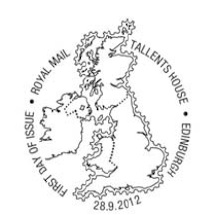
|
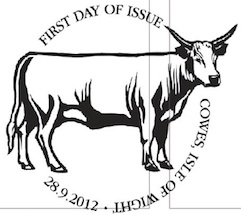
|
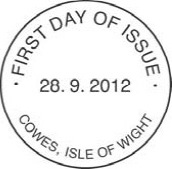
|
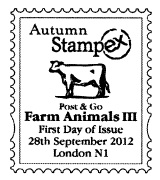
|
Ref FD1240
Philatelic Bureau Official Postmark illustrated with a map of the
British Isles |
Ref FD1241
Cowes Isle of Wight official postmark illustrated with a cow (The
postmark will not have the frame lines)
|
Ref FD1241NP
Cowes, Isle of Wight official non-pictorial postmark. |
Ref L12708
Autumn Stampex Post & Go Farm Animals III London N1
|
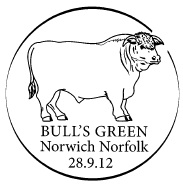
|
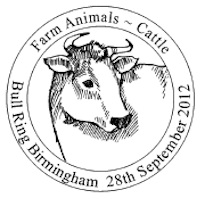 |
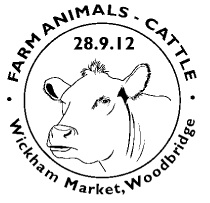
|

|
Ref L12709 Bull's Green, Norwich, Norfolk.
This is incorrect as the correct address
for Bull's Green is 'Toft Monks, Beccles, Suffolk". The
postmark may be changed.
|
Ref M12714
Bull Ring, Birmingham |
Ref L12727 Wickham Market, Woodbridge (Suffolk) ( Home of Red
Poll Cattle Society.)
|
Ref M12728 Lighthorne, Warwickshire (Location of White
Park Cattle Society)
|
This page updated 8 October 2012
If you wish to be told when this page is updated, please use the
ChangeDetection box at the top of this page.
If you have any questions, please email
us.
NB: all emails will be acknowledged in 1-2 days
unless we are away (see home page). If you do not receive an
acknowledgement please email us from a different address (eg hotmail,
gmail).
Instant
Printing Prices from Webmart


